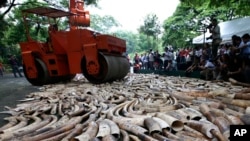MANILA —
The Philippine government Friday began destroying more than five tons of confiscated elephant tusks. The Philippines is one of the main stopovers on the illicit ivory trade route from Africa to China.
The tusks were part of a stockpile that was collected over a 17-year period through 2009. But this is only about half of what was originally confiscated. Officials said the search and investigation continues for the nearly eight tons of missing ivory.
Environment and Natural Resources Secretary Ramon Paje hopes that destroying the tusks in a very public way will be a deterrent to smugglers. “This act is a strong statement to the rest of the world that the Philippines is serious and will not tolerate illegal wildlife trade,” he said.
An investigative report published by National Geographic Magazine in October found the Philippines was not only a major transit point for raw ivory, but that it was also a big consumer of religious icons made of the material.
Investigative journalist Bryan Christy, who wrote the story, gave a presentation prior to the tusk destruction. “Wildlife trafficking is among the most profitable forms, perhaps the most profitable form, of illegal transnational crime because of the penalties," he stated. "The profits are good. But the penalties are close to zero.”
Christy said in 1989 when Kenya burned 13 tons of ivory tusks, the act prompted CITES - the Convention on International Trade in Endangered Species - to ban the ivory trade worldwide. He says the ban worked until CITES allowed some ivory to be sold in Japan in 1999 and then in China in 2008. Christy says China’s demand for ivory parallels its rising prosperity.
The National Geographic investigation found that ivory is mostly used for religious carvings in China, the Philippines, Malaysia, Thailand and Vietnam.
Christy says the ivory trade is a $50 million a year industry and may be much larger, since only about 10 percent of the trade has been traced.
Still, Lusaka Agreement Task Force Representative Bonaventure Ebayi was optimistic the public destruction of ivory in Manila could bring about a change on an even bigger scale than what happened in Kenya in 1989. “This is the first time that a consuming country decides voluntarily to destroy the ivory. It is a stronger message,” he said.
Philippine environmental officials say the going rate for raw ivory is about $200 per kilogram.
The tusks were part of a stockpile that was collected over a 17-year period through 2009. But this is only about half of what was originally confiscated. Officials said the search and investigation continues for the nearly eight tons of missing ivory.
Environment and Natural Resources Secretary Ramon Paje hopes that destroying the tusks in a very public way will be a deterrent to smugglers. “This act is a strong statement to the rest of the world that the Philippines is serious and will not tolerate illegal wildlife trade,” he said.
An investigative report published by National Geographic Magazine in October found the Philippines was not only a major transit point for raw ivory, but that it was also a big consumer of religious icons made of the material.
Investigative journalist Bryan Christy, who wrote the story, gave a presentation prior to the tusk destruction. “Wildlife trafficking is among the most profitable forms, perhaps the most profitable form, of illegal transnational crime because of the penalties," he stated. "The profits are good. But the penalties are close to zero.”
Christy said in 1989 when Kenya burned 13 tons of ivory tusks, the act prompted CITES - the Convention on International Trade in Endangered Species - to ban the ivory trade worldwide. He says the ban worked until CITES allowed some ivory to be sold in Japan in 1999 and then in China in 2008. Christy says China’s demand for ivory parallels its rising prosperity.
The National Geographic investigation found that ivory is mostly used for religious carvings in China, the Philippines, Malaysia, Thailand and Vietnam.
Christy says the ivory trade is a $50 million a year industry and may be much larger, since only about 10 percent of the trade has been traced.
Still, Lusaka Agreement Task Force Representative Bonaventure Ebayi was optimistic the public destruction of ivory in Manila could bring about a change on an even bigger scale than what happened in Kenya in 1989. “This is the first time that a consuming country decides voluntarily to destroy the ivory. It is a stronger message,” he said.
Philippine environmental officials say the going rate for raw ivory is about $200 per kilogram.












